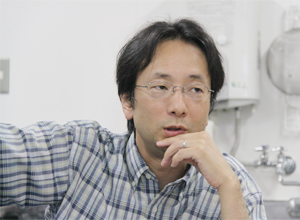Genomic rejuvenation is the “secret of youth” of daughter cells in budding yeast!

Takehiko KOBAYASHI, D. Sc., Professor,
Division of Cytogenetics, Department of Cell Genetics,
National Institute of Genetics/ SOKENDAI.
Cells monitor their own aging during repeating cell division and die once at a certain level of aging. Cellular aging is an important factor that determines the lifespan of living organisms, although the monitoring mechanism is not analyzed well. Professor Takehiko KOBAYASHI (Division of Cytogenetics) has carried out experiments using the budding yeast, S. cerevisiae with the hypothesis that reduced genomes stability causes cellular aging. As a result, he has found that certain group of repetitive genes has a mechanism for transmitting damage-less genes to the subsequent generation and that the level of stability of this genes regulates aging and lifespan.

For living organisms to continue their lineage without fail, they must transmit the genetic information to the progenies in a damage-less perfect state. However, in the process of replication and distribution of parent genes, damages (mutations, rearrangement, etc) can occur at a certain rate. For example, chromosome nondisjunction and genetic deficiency are grave flaws that must be avoided. On the other hand, a minor damage such as basic substitution may be beneficial in terms of evolution or acquisition of diversity. “I wanted to know to what extent a genetic flaw is permissible and what mechanism comes into play to repair damages,” says Dr. Kobayashi, who has been studying DNA evolution and plasticity by analyzing gene amplification in yeast.
Budding yeast, a single-cell eukaryote, grows by cell division (budding) or sporulation, depending on nutrition and other conditions. When they grow by cell division, one generation lasts about 2 hours, and daughter cells are the clones of mother cells with the identical genomic information. Dr. Kobayashi carried out analyses using a yeast strain that is modified in such a way as to multiply only by cell division, focusing on the repeat number of repetitive genes called rDNA (ribosomal RNA gene cluster).
One budding yeast (mother cell) dies of cellular aging after about 20 cell divisions. Its daughter cell, regardless of the mother cell’s aging, has the ability to repeat about 20 cell divisions and produce another daughter cells. Therefore, it is possible to say that the daughter cell goes on living permanently. Dr. Kobayashi says, “in our experiment, we have demonstrated that an aged mother cell is able to produce a young daughter cell because genomic rejuvenation (re-setting) occurs when genes are replicated and daughter genomes are produced.”
Dr. Kobayashi and his team also examined how rDNA is given to the daughter cell. rDNA is a repetitive gene (~150 copies) which codes the ribosomal RNA (rRNA), and is transmitted to the daughter cell in a damage-less state. “Generally, repetitive genes are unstable and easily broken by recombination among the repeats, but specific mechanisms operate on the daughter rDNA to verify that they are in a correct sequence and remove abnormalities,” explains Dr. Kobayashi. On the other hand, in the mother rDNA, the stability becomes worse as the cell divides and aging advances.
Moreover, Dr. Kobayashi has established a mutant in the recombination process. He has discovered that its lifespan of mother cell is extended, whereas flaws on rDNA are transmitted to daughter cells unrepaired, resulting in the extinction of the strain. Dr. Kobayashi says, “these results indicate that the stability of rDNA functions as a monitor of DNA damage, regulating aging and life span. I believe that human cells also have a similar mechanism. In fact, reduced stability of rDNA has been reported in cases of premature senescence such as Werner syndrome.”

The process of human aging is a black box still remaining in biology. It would not be simple to study its mechanism in higher animals because aging takes about two years even for mice and dozens of years for monkeys and other primates. Yeasts, on the other hand, are an ideal model for its short generational cycle. “The budding yeast has the advantage of being compatible with conventional genetic methods since they grow also by sexual reproduction. We have also started to look into how gametogenesis is related to aging using yeasts. We hope to work eventually on the mechanism of chromosome nondisjunction, which causes Down syndrome, among others,” says Dr. Kobayashi. His endeavor with yeasts only 5 microns across goes on…
(Interviewed by Naoko Nishimura on Aug. 5, 2009)
The effect of replication initiation on gene amplification in the rDNA and its relationship to aging
Ganley, A.R.D., Ide, S., Saka, K., and Kobayashi, T. Molecular Cell, Vol. 35, Issue 5, 683-693, 2009. DOI: 10.1016/j.molcel.2009.07.012
Back














